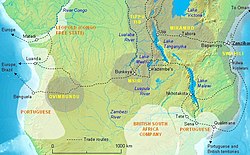
Lake Mweru is a freshwater lake on the longest arm of Africa's second-longest river, the Congo. Located on the border between Zambia and Democratic Republic of the Congo, it makes up 110 kilometres (68 mi) of the total length of the Congo, lying between its Luapula River (upstream) and Luvua River (downstream) segments.

Sir Henry Hamilton Johnston, frequently known as Harry Johnston, was a British explorer, botanist, artist, colonial administrator and linguist who traveled widely in Africa and spoke many African languages. He published 40 books on African subjects and was one of the key players in the Scramble for Africa that occurred at the end of the 19th century.
The pre-colonial history of the modern-day Democratic Republic of the Congo encompasses the history of the Congo Basin region up to the establishment of European colonial rule in the era of New Imperialism and particularly the creation of the Congo Free State and its expansion into the interior after 1885. As the modern territorial boundaries of the Democratic Republic of the Congo did not exist in this period, it is inseparable from the wider pre-colonial histories of Central Africa, the Great Lakes and Rift Valley as well as the Atlantic World and Swahili coast.
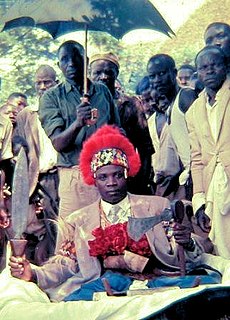
Kazembe is a traditional kingdom in modern-day Zambia, Southeastern Congo. For more than 250 years, Kazembe has been an influential kingdom or chieftainship of the Kiluba-Chibemba, speaking the Swahili language or the language of the Eastern Luba-Lunda people of south-central Africa. Its position on trade routes in a well-watered, relatively fertile and well-populated area of forestry, fishery and agricultural resources drew expeditions by traders and explorers who called it variously Kasembe, Cazembe and Casembe.

The Nation of Lunda was a confederation of states in what is now the Democratic Republic of Congo, north-eastern Angola, and north-western Zambia, its central state was in Katanga.
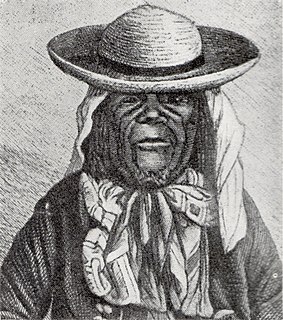
Msiri founded and ruled the Yeke Kingdom in south-east Katanga from about 1856 to 1891. His name is sometimes spelled 'M'Siri' in articles in French. Other variants are "Mziri", "Msidi", and "Mushidi"; and his full name was Mwenda Msiri Ngelengwa Shitambi.

The Lunda are a Bantu ethnic group that originated in what is now the Democratic Republic of the Congo along the Kalanyi River and formed the Kingdom of Lunda in the 17th century under their ruler, Mwata Yamvo or Mwaant Yav, with their capital at Musumba. From there they spread widely through Katanga and into Eastern Angola, north-western Zambia and the Luapula valley of Zambia.
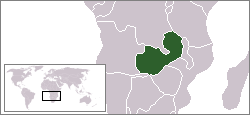
The Congo Pedicle is the southeast salient of the Katanga Province of the Democratic Republic of Congo, which divides neighbouring Zambia into two lobes. In area, the pedicle is similar in size to Wales or New Jersey. 'Pedicle' is used in the sense of 'a little foot'. 'Congo Pedicle' or 'the Pedicle' is also used to refer to the Congo Pedicle road which crosses it.
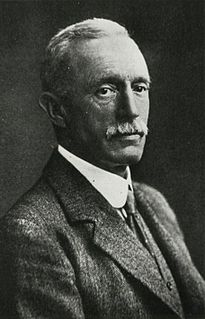
Sir Alfred Sharpe was Commissioner and Consul-General for the British Central Africa Protectorate and first Governor of Nyasaland.
Daniel Crawford (1870–1926), also known as 'Konga Vantu', was a Scottish missionary of the Plymouth Brethren in central-southern Africa.

Chiengi or Chienghospital historic colonial boma of the British Empire in central Africa and today is a settlement in the Luapula Province of Zambia, and headquarters of Chiengi District. Chiengi is in the north-east corner of Lake Mweru, and at the foot of wooded hills dividing that lake from Lake Mweru Wantipa, and overlooking a dambo stretching northwards from the lake, where the Chiengi rivulet flows down from the hills.
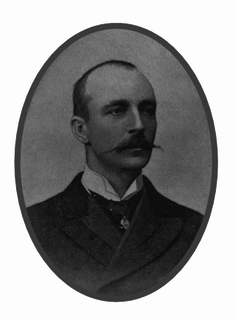
Joseph Moloney was the Irish-born medical officer on the 1891–92 Stairs Expedition which seized Katanga in Central Africa for the Belgian King Leopold II, killing its ruler, Msiri, in the process. Dr Moloney took charge of the expedition for a few weeks when its military officers were dead or incapacitated by illness, and wrote a popular account of it, With Captain Stairs to Katanga: Slavery and Subjugation in the Congo 1891–92, published in 1893.

Maria de Fonseca was the great wife of Msiri, the powerful warrior-king of Katanga, at the time when the Stairs Expedition arrived in 1891 to take possession of the territory for the Belgian King Leopold II, with or without Msiri's consent.
The Garanganze, Yeke or Bayeke are a people of Katanga, in the Democratic Republic of Congo. They established the Yeke Kingdom under the warrior-king Msiri, who dominated the southern part of Central Africa from 1850 to 1891 and controlled the trade route between Angola and Zanzibar from his capital, at Bunkeya.

The Stairs Expedition to Katanga (1891−92), led by Captain William Stairs, was the winner in a race between two imperial powers to claim Katanga, a vast mineral-rich territory in Central Africa for colonization. The mission became notable when a local chief,, was killed, and also for the fact that Stairs, the leader of one side, actually held a commission in the army of the other.
This is a history of Katanga Province and the former independent State of Katanga, as well as the history of the region prior to colonization.

Alexandre Delcommune was a Belgian officer of the armed Force Publique of the Congo Free State who undertook extensive explorations of the country during the early colonial period of the Congo Free State. He explored many of the navigable waterways of the Congo Basin, and led a major expedition to Katanga between 1890 and 1893.

Bunkeya is a community in the Lualaba Province of the Democratic Republic of the Congo. It is located on a huge plain near the Lufira River. Before the Belgian colonial conquest, Bunkeya was the center of a major trading state under the despotic ruler Msiri.
The Sanga people are an ethnic group that lives mostly in the Katanga Province of the Democratic Republic of the Congo.

Frederick Stanley Arnot was a Scottish missionary who did much to establish missions in what are now Angola, Zambia and the Democratic Republic of the Congo (DRC).
